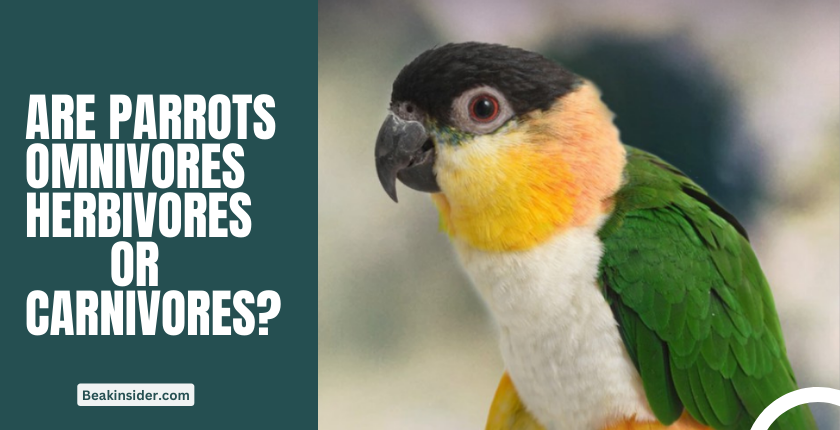Parrots are primarily herbivores when it comes to flourishing and omnivores when it comes to diversifying.
Parrots being fascinating creatures are liked by many and to keep this playful animal active, being aware of their nutritional needs is also essential. As a first-time bird pet owner, you might have this intriguing query whether they are herbivores, carnivores, or omnivores.
Therefore, to unravel this mystery, join us in this blog to learn about parrots omnivores, herbivores, or carnivores and which diet suits them best for their good well-being.
Are Parrots Omnivores, Herbivores, or Carnivores?
Herbivores are the animals or species that only eat plants, carnivores are the animals that consume meat, while omnivores eat both plants and meat.
Most of them depend on vegetarian sources of food, while most parrots living in forests have insects and some sources of meat when available.
They are also well known for their love for fruits, nuts, seeds, and plants. Therefore, you cannot fully say whether they are herbivores, omnivores, or carnivores.
When talking about food, parrots have quite an adaptive nature. They show traits common in both omnivores and herbivores. Although their primary food source is plant-based food items, however, they occasionally eat meat as well. Being able to eat meat does not make them carnivores unless they thrive on it.
It is best to understand that parrots cannot rely on eating meat only and it can be harmful for them at times, so a vegetarian diet is considered to be an essential source for eating as well.
So, parrots are primarily herbivores when it comes to flourishing and omnivores when it comes to diversifying.
All in all, a well-balanced diet plays a crucial role to ensure good health and well-being. However, their diet flexibility is probably impacted by certain factors like seasonal food availability, breeding demands, or dietary requirements.
Putting it simply, despite tending herbivory, parrots are capable of eating both plant and animal stuff as well. They are fascinating and distinctive species that deserve our attention and best care when it comes to their adaptability.
Parrots in Wild: What Do They Eat?
While talking about what parrots eat in the wild, they don’t hunt for any specific food items while living in forests, they can eat almost every type of food including vegetables of any kind they find around, seeds, nuts, flowers, occasionally some insects or meat as well.
Some breeds of parrots like Cockatoos, Budgies, and other breeds thrive on eating seeds or nuts. Another breed like Eclectus also primarily depends on fruits. It depends on their unique digestive system. All in all, every breed has its eating preferences and behaviors.
Their diet also varies with the environment. It plays a crucial role in deciding what parrots can eat or what is available for them in a particular environment.
Omnivorous Tendencies in Parrots
As explained earlier, omnivores are animal species that can consume both plants and animal sources to survive. Their anatomical behaviors let them consume various nutrients from several dietary sources. Putting it simply, they can have all kinds of fruits, vegetables, seeds, insects, or even small animals.
More Details on Parrots’ Tendency to Consume BothPlants & Animals
Despite being mostly herbivorous, parrots exhibit some clear omnivorous tendencies as well. having long and strong beaks, they can reach nuts and seeds while enabling them to eat a variety of foods and other animal-derived food sources as well.
Some Common Examples of Omnivorous Behaviors Seen in Parrots
1. Eating Insects
Ants, beetles, and caterpillars are among the common insects that parrots have been seen hunting for, specifically during their breeding seasons when they need additional protein for development and reproduction.
2. Opportunistic Hunting
Parrots also occasionally consume the remains of small animals to survive. This behavior is mostly seen in certain species of New Zealand where Kea parrots are mostly seen.
3. Nectar Feeding
While nectar is primarily a plant-based source, some parrot breeds like; Lorikeets feed themselves rich-flowers nectar. These parrots have distinctive tongues and beaks specifically adapted to consume nectar.
These examples clearly state how parrots are adaptable and may use a variety of food sources to suit their nutritional needs. While the majority of their diet still consists of plants, their eating habits also include animal products, demonstrating their omnivorous nature.
It is to keep in mind that when deciding on what to feed parrots, both as pets or in the wild, it is significantly important to maintain a well-balanced diet to keep them healthy and active.
Herbivorous Aspects of Parrots
Organisms classified as herbivores mostly rely on plant-based food sources for nourishment. These species have specialized digestive systems with large intestines and fermentation chambers to digest plant-based food efficiently.
Some Common Plant-based Foods Parrots Prefer
1. Fruits
Parrots usually like tropical fruits like apples, bananas, grapes, berries, and citrus fruits. These give them the vital vitamins, minerals, and antioxidants that they require.
2. Vegetables
Alongside fruits, parrots like to eat lots of leafy greens (like spinach and kale), carrots, broccoli, peppers, and cucumbers. These help them fulfill their needs for essential vitamins and dietary fiber.
3. Seeds & Nuts
Parrots also have a good liking for seeds and nuts as well because they provide them with essential lipids, proteins, and energy. Some common examples are sunflower seeds, almonds, walnuts, or pine nuts.
4. Flowers & Buds
There are some specific breeds of parrots like the African grey parrot, that like to consume flowers and buds to help them fulfill their dietary needs and provide them vital nutrients.
Some of the essential nutrients like vitamins A, C, and E, or other antioxidants via plant-based food sources. It helps them maintain their general well-being and brilliance.
Carnivorous Behaviors in Parrots
Carnivores are species whose main food source is animals. These creatures have strong teeth and jaws to help them catch and tear the prey easily. Carnivorous creatures have a short digestive system specifically designed to process animal protein efficiently.
Understanding the Some Occurrences of Carnivorous Behavior in Parrots
Although parrots are known for their herbivorous nature, there have been a few breeds showing carnivorous behavior among them. These types of parrots opt for eating tiny insects, grubs, or even small vertebrates like lizards or birds.
Factors that Highlight Carnivorous Behavior of Parrots
1. Lack of Plant Food Sources
Locations or environments with few plant food sources or during specific seasons make parrots turn to eating animal remains as a backup source of nourishment.
2. Nutritional Requirements
Nutritional requirements are also one main reason for parrots becoming carnivores. Some parrots may need a diet with more protein, particularly when they are breeding. These establish carnivorous behaviors in such cases to fulfill their dietary needs.
3. Taking Advantage of Opportunities to Eat
Parrots are bright and adaptive birds. When these species are given the option or when possible, advantages outweigh the hazards, they turn into carnivores to consume tiny animals.
It is crucial to remember here that parrots rarely exhibit carnivorous behaviors, which do not necessarily reflect their preferred diets. They have predominantly evolved herbivorous lifestyles through their anatomy and physiology.
Nevertheless, these infrequent acts of carnivory shed light on parrots’ capacity for adaptation and their capacity to deal with a variety of situations in their native settings.
The Ideal Diets of Parrots Must Have
When talking about the ideal diets that parrots must have, there is no specific food item to opt for. Instead, parrots should have a variety of fresh fruits, vegetables, seeds, and occasionally lean protein sources in their meals to fulfill their nutritional needs and help in their nourishment. Their good health is fully reliant on what they eat and so it must be a well-balanced diet.
The Importance of Proper Nutrition for Pet Parrots
The importance of proper nutrients cannot be emphasized enough to ensure parrots’ good wellness. Similar to other creatures, a balanced diet is significantly important for maintaining their general health, preventing sickness, and extending their lives.
To Sum it Up
New to keeping parrots as pets, and wondering if are parrots omnivores, herbivores, or carnivores, then this content is the best pick for you. It explained everything you need to know to get a thorough understanding of omnivorous, herbivorous, or carnivorous behaviors in parrots and what food sources are best for them.

I’m Amna, and I absolutely adore birds, especially parrots. I’ve been immersed in the world of these colorful feathered friends for over 10 years. While I’m not a bird doctor, I’ve gathered a wealth of knowledge on how to care for and understand them.
My experiences extend to various bird species like parrots, macaws, cockatoos, canaries, and finches. In addition to my personal adventures with birds, I’ve dedicated time to volunteering at a local bird rehabilitation center.
My true passion lies in sharing what I know about parrots and birds with you. Through my articles, I aim to share the information you need to provide the very best care for your avian companions. So, let’s embark on this journey together and make your feathered friends’ lives as joyful and healthy as possible!

